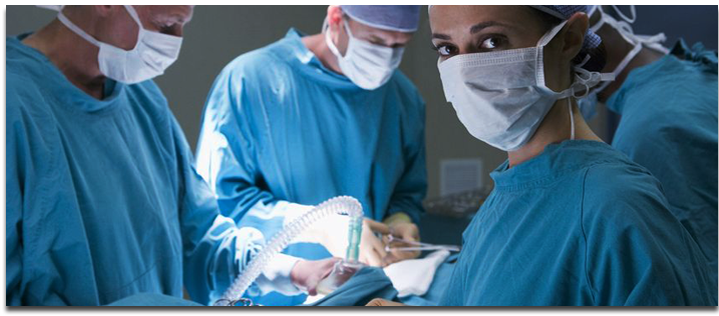


![]()
Diagnostic Laparoscopy
Diagnostic laparoscopy ( when the diagnosis is in doubt even after all investigations)
Abdomen is packed with various organs which sometimes present with symptoms mimicking each other. On several occasions it may be difficult to pin point the exact disease and organ involved even after using highly specialized imaging. In conditions such as recurrent pain in the abdomen when all tests are inconclusive we now have a choice of introducing a camera through a 1cm incision around the belly button to see and diagnose the disease. Several times diseases such as tuberculosis of abdomen, appendicitis, ovarian disease, adhesions and abdominal spread of cancers cannot be made out even if we use sophisticated scans. In such conditions laparoscopy is of great advantage because not only can we diagnose the illness we can treat is appropriately in the same sitting. Additional instruments are introduced to the abdomen via separate incisions to perform the surgery.
Laparoscopic appendicectomy
Laparoscopic cholecystectomy (removal of gall bladder)
Gall bladder stones usually develop in ladies due to several hormonal and metabolic factors. Once formed the only method of treatment is surgical removal of gall bladder including the stones. Gall stones if left alone can get infected which produces severe pain in the right upper abdomen and vomiting. The stones can slip down into bile duct (which takes bile from liver to intestine) and can cause jaundice in patients. Large single stones if untreated for long time have a small but definite chance of causing cancer of gall bladder. This surgery can now be done by latest technique called SILS where a single incision is made around the umbilicus (belly button) and surgery performed. In a routine case the patient is hospitalized for 24-48 hrs.
Laparoscopic inguinal hernia repair ( groin hernia repair)
Inguinal hernia is a common surgically correctable disease. Surgery is indicated in patients mainly to prevent the complications which may arise as a result of intestines getting caught in the hernia. In hernia patients the abdominal wall is weak near the groin where the spermatic cord comes out. Through this defect the abdominal contents such as bowel and bladder tends to come out of the abdomen. Surgery is done to plug the defect using prosthetic materials called “Mesh”. In routine cases the patient is discharged within 24-48 hrs. of surgery. He is encouraged to do his routine activities as soon as he is comfortable. Light exercises walking and swimming is encouraged however lifting heavy weights and strenuous exercise is discouraged for up to 3 months after surgery. The main advantages of laparoscopic hernia repair is in cases of recurrent hernia (recurrence following previous open surgery) and in bilateral hernias were same three puncture wounds are used to repair both the sides.
Laparoscopic umbilical hernia repair
Hernias around umbilicus are common more so in ladies and incisional hernia is the hernia that occurs in previous surgical scars due to various reasons. The open surgical repair in these cases in associated with significant hospital stay due to pain associated with wide dissection around the hernia. In laparoscopic repair however the patient recovery is much faster and there are also studies to demonstrate lower recurrence rates after laparoscopic repair in these hernias. A special type of mesh is placed from inside the abdomen to cover the hernia defect and is fixed to the abdominal wall using fixation device. The advantage of laparoscopic surgery here is that sometimes there more than one defect in the hernia which are better visualized from inside in laparoscopy than in open surgery. Hence recurrence rates are less in laparoscopic surgery.
Laparoscopic incisional hernia repair( hernia following pervious abdominal surgery)
Laparoscopic perforation closure ( stomach or duodenal perforation)
Stomach is an amazing organ and is capable of withstanding a lot of stress. Sometimes however due to various reasons a person may be suffering from ulcer disease. One of the complications of ulcer disease is ulcer perforation. When this happens there is sudden pain in the abdomen and vomiting. Patients develop severe abdominal pain and distension. This is a serious condition needing prompt surgical intervention once patient is stabilized. Earlier the surgery was performed by making a large midline incision on the patient. This wound has a high chance of infection and also at later date give rise to incisional hernia. Laparoscopic repair of perforation can be done using three or four small less than 1cm wound. There is less pain post-operatively in these patients. Although there is a slight risk of intra- abdominal collection of pus after laparoscopy this can be tackled by repeat laparoscopy and antibiotics.
Laparoscopic splenectomy
Spleen is another organ that is affected by certain diseases for which surgery is the only treatment. ITP is a condition where the patients lose platelets (a Critical blood component required for clotting) due to hyperfuncting spleen. Removal of spleen in these patients gives dramatic results. Spleen is a deep seated organ and is sometimes very large in size when diseased. It needs careful handling and hence in open surgery often the incision made to access the spleen without injuring it is very large. Laparoscopy undoubtedly is a better alternative for these patients where the recovery period is shortened to 2 days from 10 days in open surgery. Since the specimen is broken down into pieces within a protective bag the incision remains small and the patient is greatly benefitted.
Laparoscopic surgery for cancer of stomach and colon
Laparoscopic surgery for hiatus hernia
Laparoscopic surgery for achalasia cardia
Laparoscopic surgery for undescended abdominal testis
Laparoscopic surgery for ovarian and uterine disorders( hysterectomy)
Single Incision Laparoscopic Surgery for gall baladder removal, appendicectomy,
hysterectomy, umbilical hernia.
Single incision laparoscopic surgery is the latest innovation in the field of laparoscopic surgery. As the availability and awareness of laparoscopic surgery (key hole surgery) is increasing among all, the desire to further reduce the number incision has given rise to this new procedure.Conventional laparoscopy which is regarded as the gold standard for many surgeries involves making of multiple small incisions to access the abdomen and carry out the surgery. In the new technique only a single incision of about 2cms in made around the umbilicus (belly button) and all the working instruments are inserted through a special port designed for the purpose. Although the surgery is of great benefit to the patient, performing the procedure is very demanding and needs significant expertise on the part of the surgeon. Any surgery entitles risks but in this case the risks are not more than conventional laparoscopic surgery. Many surgical procedures such as appendectomies, cholecystectomies any hystrectomies can be performed by this method. The cost of the procedure is marginally higher from routine laparoscopic surgery as it entails use of specialized instruments and port.




